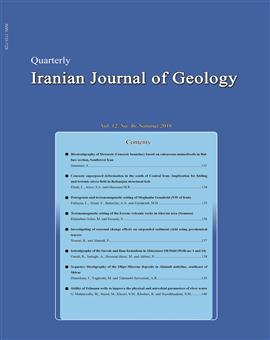-
-
List of Articles
-
Open Access Article
1 - Biostratigraphy of Mesozoic-Cenozoic boundary based on calcareous nannofossils in Bulfars section, Southwest Iran
Saeedeh Senemari -
Open Access Article
2 - Cenozoic superposed deformation in the south of Central Iran: Implication for folding and tectonic stress field in Rafsanjan structural belt
لیلا عبادی Seyd Ahmad Alavi Mohamad Reaz Ghasemi -
Open Access Article
3 - Petrogensis and tectonomagmatic setting of Moghanlu Granitoid (NW of Iran)
Fatemeh Najmi Leili Fathiyan Seyed Ahmad Mazaheri Farhad Aliani Saeid Saadat Ali Akbar Baharifar Azam Entezari Mohamad Hossian Zarinkoub -
Open Access Article
4 - Tectonomagmatic setting of the Eocene volcanic rocks in Ahovan area (Semnan)
Maryam Alipour Morteza Khalatbari-Jafari Mohsen Pourkermani Sedigheh Etesami Ali Sorbi -
Open Access Article
5 - Investigating of seasonal change effects on suspended sediment yield using geochemical tracers
Kazem Nosrati فروزان احمدی -
Open Access Article
6 - Biostratigraphy of the Sarvak and Ilam formations in Abteymoor Oil Field (Wells no. 1 and 14)
Reza Omidi Mahmoud Jalali Mahboubeh Hooseni-barzi Narges Akbari -
Open Access Article
7 - Sequence Stratigraphy of Oligo-Miocene deposits at Ahmadi anticline, southeast of Shiraz
Jahanbakhsh Daneshian Mohsen Yaghoobi Alireza Tahmasbi Sarvestani -
Open Access Article
8 - Ability of Felmann wells to improve the physical and microbial parameters of river water
Mojtaba G.Mahmoodlu Mostfa Seyed Seyd Mostafa Khezri Gholam Abbas Fanaei Kheirabad
-
The rights to this website are owned by the Raimag Press Management System.
Copyright © 2017-2026







